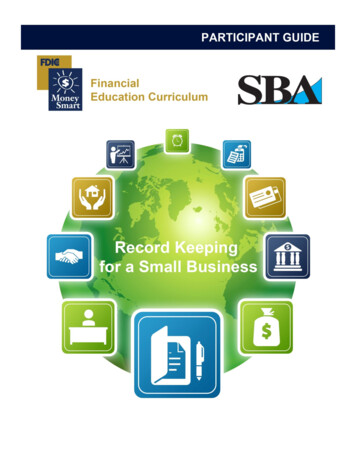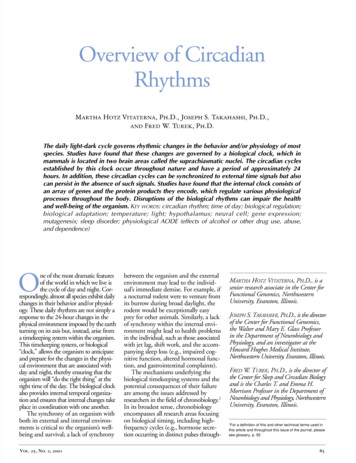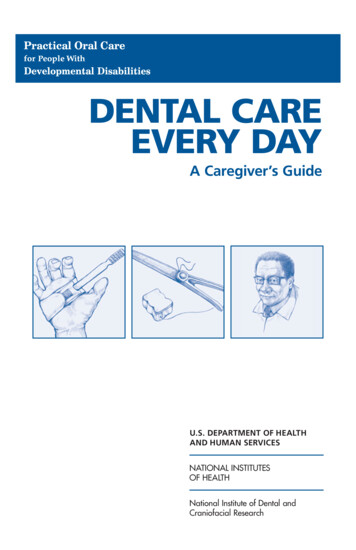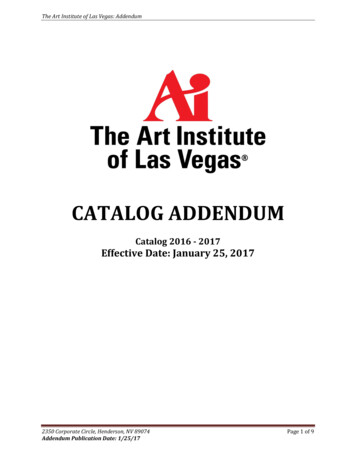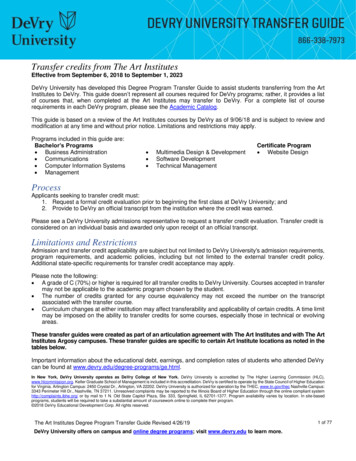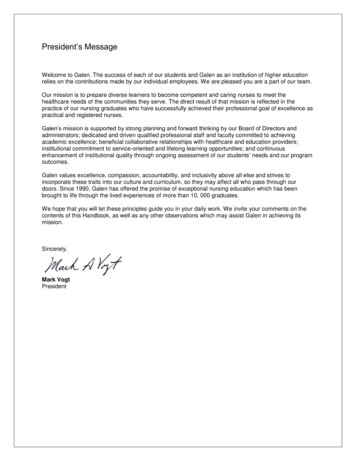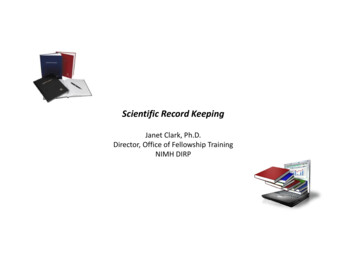
Transcription
Scientific Record KeepingJanet Clark, Ph.D.Director, Office of Fellowship TrainingNIMH DIRP
Reasons Good Record Keeping is Critical in Scientific Research Data analysis, writing publications, drafting presentations/posters,collaboration, peer review, data replication Required by NIH to meet accepted policies and standards for conduct of goodscience* Including specialized record keeping required for radioactive materials,biological materials, recombinant DNA, scheduled drugs for DEA, Food andDrug Administration (FDA), animal work To support intellectual property claims* Proof of conception of invention To aid in defense against false allegations of research misconduct Care of human subjects* Particularly high standards for research involving human subjects* Maintenance and access of records scrutinized* Confidentiality is key
What is data?Definition of data:“Factual information (as measurements or statistics) used as abasis for reasoning, discussion, or calculation.” (The Merriam-Webster Dictionary)For the purposes of scientific record keeping laboratory data include: Tangible data such as gels, slides, photographs, and computer printouts Calculations, statistical analyses, sample keys, etc. Intangibles such as observations, conclusions and next stepsA laboratory notebook is a record of both physical & mental activities.
Scientific record keeping best practicesScientific records can be kept in various forms.Regardless of the form you choose to use, all records need to be: ell-organizedAll entries should be in English.
Scientific record keeping best practicesUseful & good research records should include the following detail: What you did – experimental protocolWhen you did it - dateWhy you did it – objectiveHow you did it – methodsWho you are (the person creating the record)What project(s) this work was part ofWho conceived of the study (if not yourself)Special materials & instruments utilizedSource of materials & instrumentsDiscussion of data – results – expected and unexpectedData handling and analysesData interpretation by yourself (and others if pertinent)Next steps based on reported results
Scientific record keeping best practicesAdditional considerations for useful & good scientific research records: Legible (if handwritten) Well organized – labeled, indexed, catalogued, etc. Accurate & complete – include (1) original data and important studydetails (meta-data) and (2) successful & unsuccessful studies andactivities Describe and date all alterations and changes to records Records should allow repetition of procedures and studies by yourself &others Are accessible to others (physically and/or electronically) both short andlong term Are stored and backed-up properly and regularly for the short & longterm (archiving) Are witnessed where needed to protect intellectual property rights Are research diaries of the researcher’s work & thoughts
Research record retentionAll notebooks and data are owned by the NIH, but may be copied(without personal identifiers if human data) at the discretion of the supervisor.
Formats for scientific record keeping Bound notebook Data kept in a linear format with no skipped pages Errors lined through, initialed and dated Data accommodated by affixing to pages or separate storage with indexing Backup requires carbon copy Requires legible handwriting or affixed computer printouts Affixed data and printouts should be signed across the page and data Loose-leaf notebook May be used as supplement to bound notebook to contain original data(X-ray films, photos, gels, electronic printouts, etc.) Allows use of preformatted data sheets Loose sheets should be dated and immediately added to binder, inchronological order, to meet standards of good science and to assureresearch integrity
Formats for scientific record keepingElectronic notebook Collection of data files from ordinary programsNotebook-like-systems requiring special commercial softwareAllows for sharing of data – security an issueMechanisms needed to assure no alteration of dataAutomatic and regular archiving of data neededPros Searching capabilities Linking between pages, studies, etc. Sharing of data within and across institutions with permissions Interoperable – can read data directly from instruments into ELN Audit trail recorded – with revision history and eSignatures Drawing tools Plugins Access of notebook from outside of the lab – without removing from the lab Generally customizableCons Bugs, upgrades and other digital issues Effort to transition Data storage – location (cloud or in house) – ownership Data security and backups – requires a reliable system Unsettled ELN market – survival of ELN support
Intellectual property considerations for scientific record keepingA bound or appropriate electronic notebook should be used and must include: Subject matterExperimental detailsSketches, diagramsStudy descriptionsStudy resultsExplanation of resultsSuccinct conclusions supported by factual dataElectronic & bound notebooks should be reviewed and entries witnessed regularly,& signed and dated by the witness* Witness may not be a co-inventor, but should be familiar with the work
Intellectual property considerations for scientific record keepingBound notebook considerations: Sign & date inside front cover Sign & date each entry Entries made in ink – ball point Entries made in chronological order Corrections made by lining out entry, signing and dating NO whiteout or erasing Consecutive pages used Photos, drawings, etc. identified, labeled, permanently affixedand both attachment and notebook page signed Data stored in a supplemental notebook must be indexed in the boundnotebook on the appropriate page of the studyElectronic notebook considerations: Regularly backed up Entries dated and locked Appropriate IT security Authenticity and verification capabilities
Record keeping in clinical research Clinical studies regulated by the Food and Drug Administration (FDA) must followGood Clinical Practice and adhere to specific guidelines found in 21CFR parts 11, 50, and 312 Patient privacy and confidentiality with civil and criminal penalties forviolating the Privacy Act Principal Investigator is responsibleClinical Research Practice requires:1. Documentation of clinical care rendered to subjects and clinical findings(medical records)2. Documentation of research procedures and results (research records)Often these records overlap
Record keeping in clinical researchMedical record/Clinical documentation Complete and accurate record of patient’s condition & treatment withdiagnosis, assessment, treatment/services, clinical course/response,adverse events Ensuring organization and continuity of care Clarifying communication between health care providers Providing clinical data for evaluating health care operations and use of resources Affording risk management and malpractice protection Complying with legal, regulatory, & institutional requirementsAll documentation must have date/time, be legible and signed, be completedin a timely manner and avoid unacceptable abbreviations
Record keeping in clinical researchClinical research records Must be handled to preserve privacy and confidentiality of research subjects* Can be done by removing identifiers and using identifying codes* Store codes safely and separately from data Protect in accordance with the Privacy Act Electronic records must be password-protected and encrypted on laptops,tablets and smart devicesRegulatory binder All essential documents that demonstrate the investigator, sponsor, and monitorhave complied with standards of good clinical practice and all regulatoryrequirements Easy access to essential documents by trial monitor, auditor, IRB or regulatoryauthorities for review and/or audit
Record keeping in clinical researchDrug accountability records Record of administration of all study drugs even those self-administered Investigator is responsible for record keeping of distribution of drug, maintenanceof drug accountability records (receipts/invoices from shipments and drugaccountability reference forms (DARFS))Research record retention All research-related records retained for at least 2 years after study completion Investigational new drug (IND) study records must be retained for 2 years afterapproval of drug marketing application or withdrawal of IND, or as indicatedby sponsor NO NIH records may be destroyed unless consistent with NIH policiesgoverning record maintenance and retention and applicable regulations
ReferencesGuidelines for Conduct of Research in the Intramural Research Program at NIH (4th Edition,2007) National Institutes of Health, Office of the Directorhttps://www.training.nih.gov/nih resourcesGuidelines for Scientific Record Keeping in the Intramural Research Program at the NIH (1stEdition, (2008) National Institutes of Health, Office of the Directorhttps://www.training.nih.gov/nih resourcesGuidelines for Responsible Data Management in Scientific ResearchClinical Tools, Inc. (2006; Funded by ORI, DHHS)A Review of Electronic Laboratory Notebooks Available in the Market TodayRubacha, M. et. Al. (2011) JALA, 16: 90.
(medical records) 2. Documentation of research procedures and results (research records) Often these records overlap . Record keeping in clinical research Medical record/Clinical documentation Complete and accurate record of patient’s condition & treatment with diagnosis, assessment, treatment/services, clinical course/response, adverse events Ensuring organization and continuity of .
